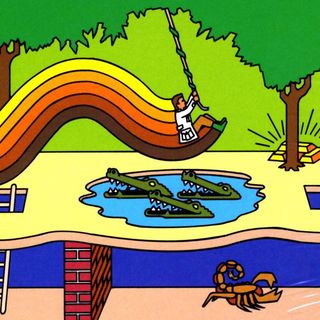Education
Eliminating the Pitfalls of Higher Education
Innovative strategies are ensuring students get to the next level in college.
Posted March 11, 2019

Do you remember Pitfall!? This Atari game had you play as Pitfall Harry, exploring the jungle for treasure while avoiding rolling logs, angry scorpions, and quicksand. The highlight of the game was swinging on vines across vast chasms and crocodile-infested waters. In all of its 8-bit glory, it made 3-year-old me feel like Tarzan and Indiana Jones rolled into one.
I was thinking about Pitfall! while attending two conferences this month. Not because I was bored, but rather because it seemed an apt metaphor for how people move through higher education. High school students think they're on a linear path toward treasure, but can be shocked to find there's a long leap to get to college. We do our best to provide a vine, but the timing is difficult and there be crocodiles. If they make it across to community college, these students face another chasm to get to a four-year university. By now they probably realize that more challenges await when they want to transition into graduate study or a career.
Each of these transitions is an opportunity for students to fall into the pit and feel like it’s Game Over. But what if instead of all of these chasms to cross, students could just keep moving forward? I was excited to learn about innovative strategies for eliminating pitfalls at both the Ohio Undergraduate Education conference (organized by the John N. Gardner Institute and hosted by Capital University in Columbus) and the Michigan College Access Network (MCAN) conference. While removing chasms would make for a terrible video game, it’s a promising approach to improving college attendance and graduation rates.

How to Beat Level One
One pitfall is from high school into postsecondary education. Traditionally, students spend a great deal of time applying to college—visiting campuses, completing forms, submitting transcripts, writing essays—and it can feel like high school and college exist on far ends of a crevasse. But what if the transition were more seamless?
At MCAN, I learned about the early middle college model being used at Charlotte High School in central Michigan. Beginning in 9th grade, any interested Charlotte student can attend a “school within a school” where they earn college credits from both Lansing Community College and Ferris State University. Students’ college course loads gradually increase until the “13th year” when they take only college courses, but with tuition, books, and fees 100% paid for with public funds. Charlotte has expanded upon this model to fit their students’ needs, offering tracks for technical education, students intending to go to four-year college, and students at risk of failing out of high school who may benefit from a different educational path that leads to a postsecondary credential.
Charlotte’s success with early middle college reflects the benefits of this model observed nationwide. As implemented and studied by Jobs for the Future, nearly a third of early college students graduate high school with an associate’s degree, preparing them for a well-paying career or continued success at a four-year university. Moreover, the average student earns 38 college credits, accelerating their journey to a credential and significantly reducing their future debt. By interleaving the secondary and postsecondary experience, a transition point that knocks many students out of higher education no longer poses such a daunting threat.
Advancing to the Next Stage
A second pitfall is encountered by community college students who want to attend a four-year university. Not only do students need to go through the college application process again, they face the extra burden of understanding which credits will apply to which courses at their new institution. Two programs I learned about in Ohio are clearing the obstacles for students taking this route to a bachelor’s degree.
Columbus State Community College has established a “Preferred Pathway” to nine different institutions, including The Ohio State University. Not only are Columbus State graduates with a GPA of 2.0 or higher guaranteed admission to Ohio State, but the two institutions jointly employ a counselor dedicated to helping students make that leap. Ohio State also runs an orientation program specifically for transfer students, designed to avoid the culture shock that leads to early academic and social struggles.
Similarly, Dayton’s Wright State University offers “The Wright Path” to students who intend to transfer from nearby Sinclair Community College. Sinclair students in this program have access to Wright State's academic resources and campus organizations, and can even live at Wright State. Students who graduate from Sinclair are guaranteed admission to Wright State and earn scholarships for GPAs above a 3.0. In both instances, these Ohio institutions have forged unique partnerships so that community college students can pursue a bachelor’s degree without feeling like they have entered a new and unfamiliar world.
Giving Students an Extra Life
Programs like early middle college and transfer partnerships are important for keeping students on track, but what can we do for students who are already off the path? Wayne State University in Detroit has pioneered a program called the Warrior Way Back to ease students’ transition from stopped-out to enrolled. Former students who owe Wayne State less than $1,500 can have that debt forgiven if they successfully complete 3 semesters. To qualify, students must take coursework that directly leads to a degree, maintain a 2.5 GPA and earn nothing less than a “C,” and complete their 3 semesters in 2 years or less.
To date, the Warrior Way Back has re-engaged 93 students—mostly students of color with high financial need, and an average age of 39 years old—with more on the way each semester. More importantly, 20 of these students have already graduated. And despite Wayne State forsaking the potential $139,500 owed by these students, Warrior Way Back has shown a return on investment of around 70%. The program has been so successful that Wayne State created a new position to advise these students, with the goal of hiring one advisor for every 100 students re-enrolled.
Lessons Learned
Pitfall! is a very difficult game, and most people who play it quit after not too long. College can be the same way; put enough venomous snakes and blazing fires in a student’s way and they’re bound give up at some point. The programs I learned about through the Gardner Institute and MCAN conferences demonstrate the need for innovative solutions to the problems plaguing the higher education pipeline. We must look for ways to simplify the transitions everyone experiences in education and make students feel like they’re on a smooth, continuous path to a college credential.




